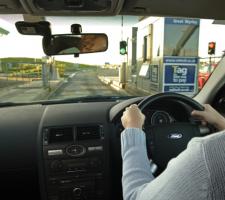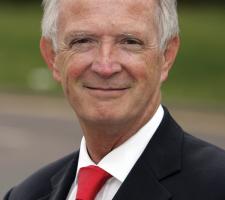
Midland Expressway Ltd's Tom Fanning discusses deployment of Near Field Communicationbased payment on the M6 Toll facility
TheNevertheless, Dedicated Short-Range Communication (DSRC)-based tags operating at 5.8GHz are still a key part of the facility's payment methodology, says chief executive Tom Fanning.
"Tag use has hit a barrier in the UK at the moment for a number of reasons but even so M6 Toll still has over 45,000 in circulation and they have proven very beneficial at peak times. M6 Toll users are offered a 5 per cent discount if they use tags rather than cash or debit/credit cards payments, and they remain the most effective means of going through our lanes for the regular user.
"Unlike the Dartford or Severn crossings, the M6 Toll is not a commuter route. Customers tend to be looking to travel up or down the country while bypassing the congested main M6. That makes tag distribution inefficient unless people are looking to use the facility upwards of three to four times a month.
Nevertheless, we have attracted regular tag users from right across the UK." In order to encourage tag use, pre-paid Quick Start tags are now available at service facilities along the M6 Toll route.
The M6Toll
The M6 Toll, or Birmingham North Relief Road, was built to provide congestion relief to the elevated section of England's M6 motorway which carries traffic over England's second-biggest city.
From the south, it runs from the M6's Junction 4 at the country's National Exhibition Centre to Junction 11 at Wolverhampton in the north. In total, there are 45 lanes and 27 miles (43km) of six-lane motorway; the road was constructed with only a few junctions, some with limited access, to discourage local traffic from using the bypass.
The facility carries around 45,000 vehicles per day and prior to the introduction of NFC there were four different payment means of toll payment, by: automated coin payments; at a staffed toll booth; automated credit or debit card; or in advance using an DSRC-based M6 Toll tag.
MEL, the road's operator, is a subsidiary of Australia's Macquarie Infrastructure Group.Take-up rates are very encouraging, according to Fanning.
However, no such decision has been forthcoming to date. Another obstacle, in Fanning's view, is the lack of a financial model as well as service providers within the European Electronic Toll Service, which is intended to bring about interoperability between toll facilities right across Europe; without a full and final set of agreed standards, facility operators are simply unwilling to take the risk of investing in a new system which could be declared obsolete overnight.
UK outlook
The UK faces additional issues, principally in terms of enforcement, which mitigate against any moves towards Open Road Tolling (ORT) at present.Fanning: "In the long term, every business wants to move to new technology that will allow it to provide its customers with a better service. But for the M6 Toll to move to ORT we'd need legislation that would allow us to pursue vehicles' registered owners and drivers, and to know who was driving.
Without that, you're not going to see ORT in the UK. The current Secretary of State for Transport is keen on this, however, and changes to the law are being looked at by the UK's Department for Transport."
Near Field Communication
NFC, therefore, was a realistic way of improving the user experience and allowed M6 Toll to piggy-back onto developments in other consumer markets."Each time we've increased our toll charges, we've seen a natural increase in debit and credit card use," Fanning continues. "Our charge from 06.00- 23.00 on Monday to Friday for a car is £5.30. That represents an average now of 6.7 coins per transaction, so it's slow.
Going to contactless technology was a natural step, therefore.
"From an authentication perspective, tags are very good. But given the nature of the M6 Toll and its user demographic, distribution would be prohibitively expensive. With contactless cards, banks provide the distribution. By the end of this year there will be around 20 million contactless payment cards in circulation in the UK and inside two years it's expected that all cards will be contactless.
"We already have one-tap payment for public transport in the UK - London's Oyster Card is an example - and with companies such as McDonald's also looking to adopt the technology we'd have been stupid not to jump on the bandwagon. It's not unprecedented in tolling; the Via Verde tap-and-go scheme in Portugal provided a solution to the massive congestion problems being encountered on bridges around Lisbon, for example.
"Lower-value transactions require a lower level of security. A lot of the retail industry isn't going to be so interested in contactless payment technology because of the typical low value of purchases.
They're also not so concerned with the speed of transaction but the technology fits well with us.
"Looking forward, we're keeping a very close eye on the use of NFC to allow mobile phones to be used as a one-tap toll 'card'. That's not fully defined yet but the technology would be very simple to implement - we believe that the timescales for introduction would be very short. In Korea, for example, we've already seen mobile phones which incorporate contactless card technology for payment applications."
18000-6C certification gets underway in the US
The non-profit OmniAir Consortium has a cooperative agreement with USDOT to develop the HIA Device Qualification Apparatus for the Connected Vehicle Program Safety Pilot. In the third quarter of 2010, the Consortium created a new, autonomous, non-profit test and certification entity, OmniAir Certification Services, Inc. (OCS). OCS's board consists of public sector operators and test experts. Unlike OmniAir, OCS was founded as a technical services organisation without members to ensure its independence from the vendor community whose devices it will test.
OCS is currently testing and certifying ISO 18000-6C tags and readers for use in surface transportation applications including parking, tolling, electronic vehicle registration/other identification and select commercial vehicle operations applications - all of which can be enabled by 6C. The goal of the programme is to assure the operator community that OCScertified tags and readers are interoperable across all certified technology vendors.
The first customer group will be the toll community. The E-470 Public Highway Authority in Denver, Colorado and other toll authorities decided to standardise on ISO 18000-6C and wanted to be sure of interoperability of the devices they procure. The OCS certification will allow them to focus on testing these devices for minimum performance in a surface transportation environment.
The 6C conformance and interoperability tests are currently in place and can be easily modified to accommodate user requirements. This will result in the industry's first interoperability certification programme.
For the tolling application, a device will be tested with several parameters such as distance, speed and orientation. The exact values and other parameters (these are the toll industry's user or functional requirements) will be provided to OCS by toll operators and other industry stakeholders.
Testing will be conducted by an OCS-accredited test center and OCS will issue a written OCS Certificate and post it to a publicly accessible device conformance/Qualified Product List (QPL).
Toll authorities or operators can conduct their own, more extensive testing on OCS-certified devices. They may include field testing in an environment resembling a toll plaza. These tests could include speed, antenna positioning, minimum field strength, device functionality, interference and so on
For further information, please contact Tim McGuckin at OCS (














